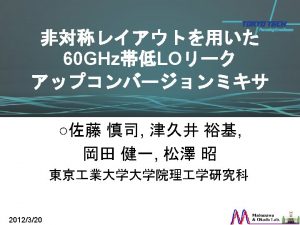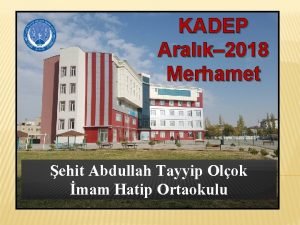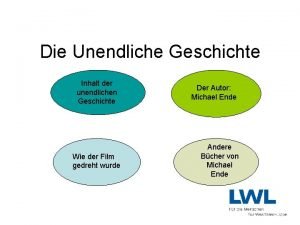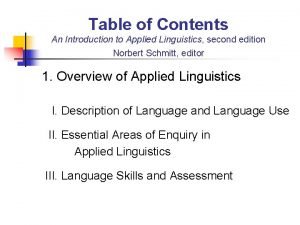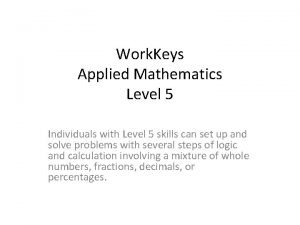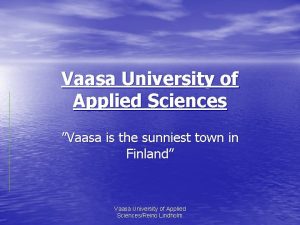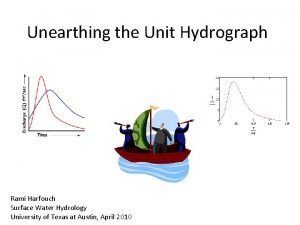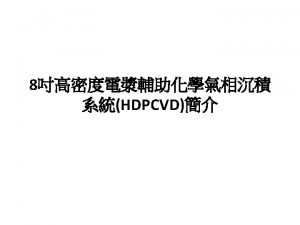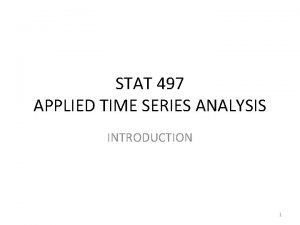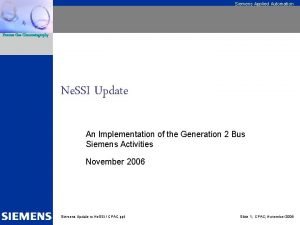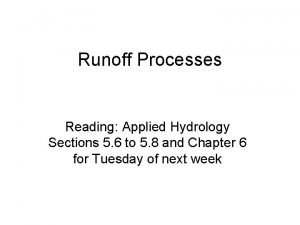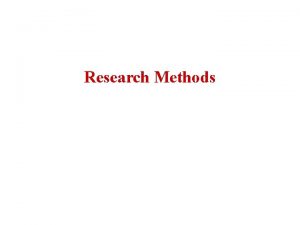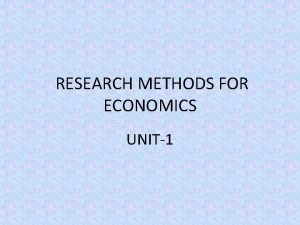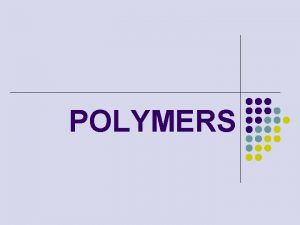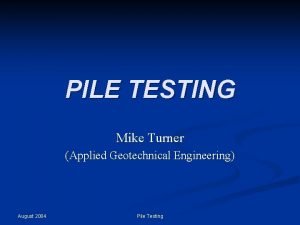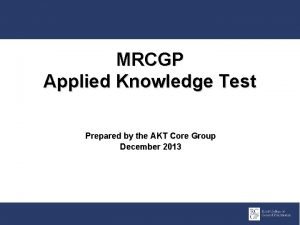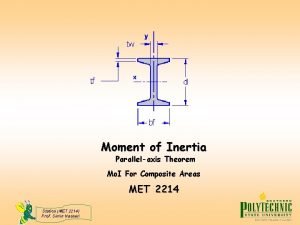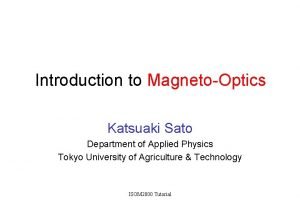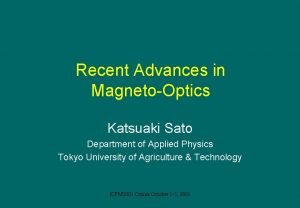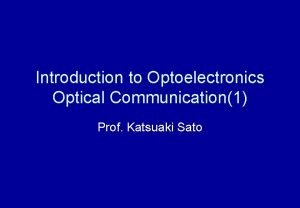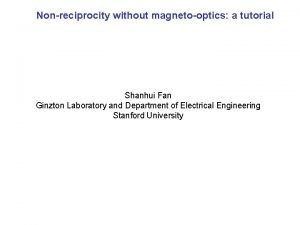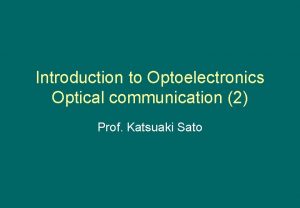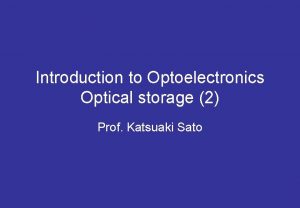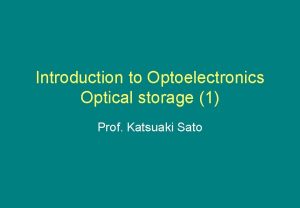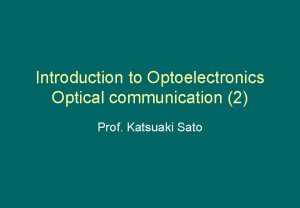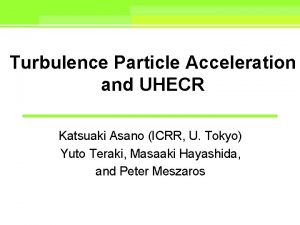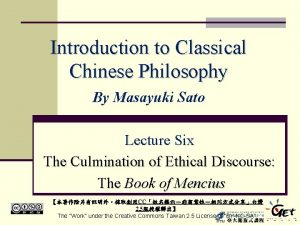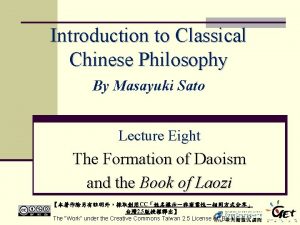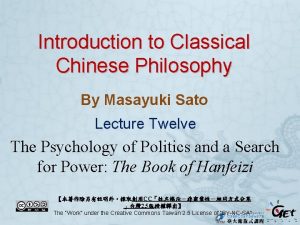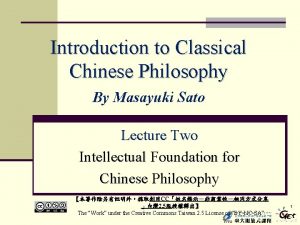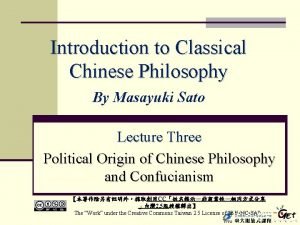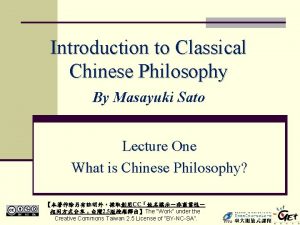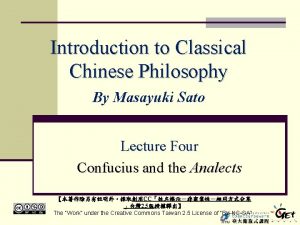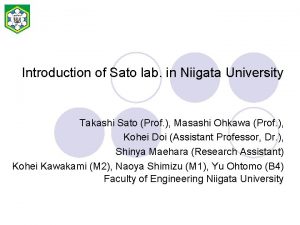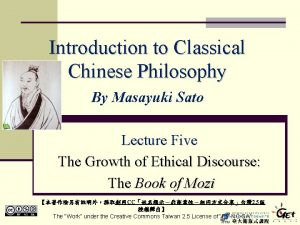Introduction to MagnetoOptics Katsuaki Sato Department of Applied





































- Slides: 37

Introduction to Magneto-Optics Katsuaki Sato Department of Applied Physics Tokyo University of Agriculture & Technology ISOM 2000 Tutorial

CONTENTS 1. 2. 3. 4. 5. 6. 7. 8. 9. Introduction Light and Magnetism What is the Magneto-Optical Effect? Electromagnetism and Magneto-Optics Electronic Theory Measurement of Magneto-Optical Effect Magneto-Optical Spectra Recent Advances in Magneto-Optics Summary

1. Introduction • Magneto-Optical Effect:Discovered by Faraday on 1845 • Phenomenon:Change of Linear Polarization to Elliptically Polarized Light Accompanied by Rotation of Principal Axis • Cause:Difference of Optical Response between LCP and RCP • Application: – – Magneto-Optical Disk Optical Isolator Current Sensors Observation Technique

2. Light and Magnetism • Light→Magnetism:Photomagentic Effect – Thermomagnetic Effect:Curie pt. recording→MO disk – Light-induced Magnetization:ruby, DMS – Light-induced spin reorientation→Optical motor • Magnetism→Light:Magneto-Optical Effect – Shift or splitting of optical absorption line(Zeeman eff. ) – Magnetic resonance:ESR, magneto-plasma effect – Magneto-optical effect(Faraday, Kerr, Cotton Mouton)

3. What is the Magneto-Optical Effect? • MO Effect in Wide Meaning Any change of optical response induced by magnetization • MO Effect in Narrow Meaning Change of intensity or polarization induced by magentization – Faraday effect – MOKE(Magneto-optical Kerr effect) – Cotton-Mouton effect

3. 1 Faraday & Voigt Configurations • (a) Faraday Configuration: – Magnetization // Light Vector • (b)Voigt Configuration: – Magnetization Light Vector

3. 2 Faraday Effect • MO effect for optical transmission – Magnetic rotation(Faraday rotation) F – Magnetic Circular Dichroism(Faraday Ellipticity) F • Comparison to Natural Optical Rotation – Faraday Effect is Nonreciprocal (Double rotation for round trip) – Natural rotation is Reciprocal (Zero for round trip) • Verdet Constant – F=Vl. H (For paramagnetic and diamagnetic materials)

Illustration of Faraday Effect For linearly polarized light incidence, Rotation of Principal axis • Elliptically polarized light goes out (MCD) Elliptically Polarized light Linearly polarized light • With the principal axis rotated (Magnetic rotation)

3. 3 Faraday rotation of magnetic materials Materials Fe rotation (deg) 3. 825・ 105 figure of merit(deg/d. B) Co 1. 88・ 105 546 〃 2 1. 11) Ni 1. 3・ 105 826 120 K 0. 27 1. 11) Y 3 Fe 5 O 12 250 1150 100 K 1. 12) Gd 2 Bi. Fe 5 O 12 1. 01・ 104 800 RT 1. 13) Mn. Sb 2. 8・ 105 500 〃 1. 14) Mn. Bi 5. 0・ 105 633 〃 1. 15) YFe. O 3 4. 9・ 103 633 〃 1. 16) Nd. Fe. O 3 4. 72・ 104 633 〃 1. 17) Cr. Br 3 1. 3・ 105 500 1. 5 K 1. 18) Eu. O 5・ 105 104 660 4. 2 K 2. 08 1. 19) Cd. Cr 2 S 4 3. 8・ 103 35(80 K) 1000 4 K 0. 6 1. 20) 44 1. 43 wavelength (nm) 578 temperat ure (K) RT Mag. field (T) 2. 4 literatu re 1. 11)

3. 4 Magneto-Optical Kerr Effect • Three kinds of MO Kerr effects – Polar Kerr(Magnetization is oriented perpendicular to the suraface) – Longitudinal Kerr(Magnetization is in plane and is parallel to the plane of incidence) – Transverse Kerr (Magnetization is in plane and is perpendicular to the plane of incidence)

3. 5 MO Kerr rotation of magnetic materials rotation Photon energy (deg) (e. V) temperat ure (K) Fe 0. 87 0. 75 RT 1. 21) Co 0. 85 0. 62 〃 1. 21) Ni 0. 19 3. 1 〃 1. 21) Gd 0. 16 4. 3 〃 1. 22) Fe 3 O 4 0. 32 1 〃 1. 23) Mn. Bi 0. 7 1. 9 〃 1. 24) Pt. Mn. Sb 2. 0 1. 75 Co. S 2 1. 1 0. 8 〃 4. 2 Cr. Br 3 3. 5 2. 9 4. 2 1. 26) Eu. O 6 2. 1 12 1. 27) USb 0. 8 Te 9. 0 0. 8 10 0. 2 Co. Cr 2 S 4 4. 5 0. 7 80 1. 29) a-Gd. Co * 0. 3 1. 9 RT 1. 30) Ce. Sb 90 2 1. 31) aterials field literature (T) 1. 7 1. 8) 0. 4 1. 25) 4. 0 1. 28)

4. Electromagnetism and Magnetooptics • Light is the electromagnetic wave. • Transmission of EM wave:Maxwell equation • Medium is regareded as continuum→dielectric permeability tensor – Effect of Magnetic field→mainly to off-diagonal element • Eigenequation • →Complex refractive index:two eigenvalues eigenfunctions:right and left circularpolarization – Phase difference between RCP and LCP→rotation – Amplitude difference →circular dichroism

4. 1 Dielectric tensor Isotromic media;M//z Invariant C 4 for 90°rotation around z-axis

4. 2 MO Equations (1) Maxwell Equation Eigenequation Eigenvalue Eigenfunction:LCP and RCP Without off-diagonal terms:No difference between LCP & RCP No magnetooptical effect

MO Equations (2) Both diagonal and off-diagonal terms contribute to Magneto-optical effect

4. 3 Phenomenology of MO effect Linearly polarized light can be decomposed to LCP and RCP Difference in phase causes rotation of the direction of Linear polarization Difference in amplitudes makes Elliptically polarized light In general, elliptically polarized light With the principal axis rotated

5. Electron theory of Magneto-Optics • Magnetization→Splitting of spin-states – No direct cause of difference of optical response between LCP and RCP • Spin-orbit interaction→Splitting of orbital states – Absorption of circular polarization→Induction of circular motion of electrons • Condition for large magneto-optical response – Presence of strong (allowed) transitions – Involving elements with large spin-orbit interaction – Not directly related with Magnetization

5. 1 Microscopic concepts of electronic polarization Wavefunction perturbed by electric field E + + - Unperturbed wavefunction + - = + + S-like + ・・ P-like Expansion by unperturbed orbitals

5. 2 Orbital angular momentum-selection rules and circular dichroism px-orbital py-orbital Lz=+1 p+=px+ipy Lz=-1 p-=px-ipy Lz=0 s-like

5. 3 Role of Spin-Orbit Interaction Jz=-3/2 Jz=-1/2 L=1 LZ=+1, 0, -1 L=0 Without magnetization LZ=0 Exchange splitting Jz=+1/2 Jz=+3/2 Jz=-1/2 Jz=+1/2 Exchange +spin-orbit

5. 4 MO lineshapes (1) 1. Diamagnetic lineshape Excited state ”xy ’xy Lz=-1 0 Lz=+1 1 2 1+2 Ground state Lz=0 Without magnetization With magnetization Photon energy

5. 4 MO lineshapes (2) excited state 0 f+ f- dielectric constant f=f+ - f ’xy ”xy ground state without magnetic field with magnetic field (a) photon energy (b)

6. Measurement of MO effect 1. Cross-polarizer technique 2. Vibrating polarizer technique 3. Rotating analyzer technique 4. Faraday modulation technique 5. Optical retardation modulation 6. Measuring system for MO spectrum 7. Measurement of elleipticity

6. 1 Cross-Nicol technique P L B A P F (a) D S A I P= A+ /2 B /4 rotation /2 rotation (b) rotation

6. 2 Vibrating polarizer technique P B + F ID S F P D A

6. 3 Rotating analyzer technique E B A=pt F ID D S P A

6. 4 Faraday modulation technique = 0+ sin pt Faraday modulator B F ID S P I=I 0+ I sin pt Zero method D A

6. 5 Retardation modulation technique i /4 B j P D PEM quartz Piezo e cryst lectric al A Isotropic medium fused silica Ca. F 2 Ge etc. Retardation =(2 / ) nl sin pt = 0 sin pt amp li tude l pos it ion

6. 6 Spectral measurement L M 1 MC Electromagnet PEM C (f Hz) M 2 P (p Hz) S A D LA 1 (f Hz) LA 2 (p Hz) Preamplifier LA 3 (2 p Hz)

6. 7 Measurement of ellipticity y E 0 sin E y’ y E 0 x x Optic axis E 0 cos x’ E’ /4 plate

7. MO spectra of materials • • Magnetic garnets Metallic ferromagnet:Fe, Co, Ni Intermetallic compounds and alloys:Pt. Mn. Sb etc. Magnetic semiconductor:Cd. Mn. Te etc. Superlattices:Pt/Co, Fe/Au etc. Amorphous:Tb. Fe. Co, Gd. Fe. Co etc. Granular:Al 2 O 3: Coなど

Theory and experiment of MO spectra in Fe Katayama theory


MO spectra in RE-TM (1) Polar Kerr rotation (min) Wavelength (nm)

MO spectra in RE-TM(2) Wavelength (nm) 300 400 500 Polar Kerr rotation (deg) 0 600 700 -0. 2 -0. 4 -0. 6 5 4 3 Photon Energy (e. V) 2

Recent Advances in Magneto-Optics • Scanning Near Field Magneto-Optical Microscope (MO-SNOM) • Nonlinear Magneto-Optics • Sagnac Magneto-Optical Microscope • X-ray Magneto-Optical Imaging

SUMMARY • Basic concept of magneto-optics is described. • Macroscopic and microscopic origins of magneto-optics are described. • Some of the recent development of magneto-optics is also given.
 Coast guard sato travel
Coast guard sato travel Sato active
Sato active Pengertian dari gambar teknik menurut takeshi sato
Pengertian dari gambar teknik menurut takeshi sato şato iho elbistan
şato iho elbistan Ecolocalizacao
Ecolocalizacao Kecap gaganti
Kecap gaganti Andrea sato
Andrea sato Alex sato
Alex sato Mariko sato michael ende
Mariko sato michael ende Sato torakiyo
Sato torakiyo Applied linguistics
Applied linguistics Introduction to bar management
Introduction to bar management Introduction to food and beverage service
Introduction to food and beverage service Introduction to food and beverage service department
Introduction to food and beverage service department Introduction to food and beverage service department
Introduction to food and beverage service department Body paragraph structure
Body paragraph structure Workkeys applied mathematics level 5 answers
Workkeys applied mathematics level 5 answers Van hall larenstein university of applied sciences
Van hall larenstein university of applied sciences University of applied sciences vaasa
University of applied sciences vaasa Cashless jukebox
Cashless jukebox Applied hydrology
Applied hydrology Applied materials hdp
Applied materials hdp Strong stationarity
Strong stationarity Siemens gas chromatograph
Siemens gas chromatograph Applied hydrology
Applied hydrology Research comes from the word
Research comes from the word Difference between empirical and conceptual research
Difference between empirical and conceptual research Research scope meaning
Research scope meaning The plastic which soften when heat is applied
The plastic which soften when heat is applied Applied geotechnical engineering
Applied geotechnical engineering Oulu university of applied sciences
Oulu university of applied sciences Rcgp akt sample questions
Rcgp akt sample questions Law of conservation of momentum
Law of conservation of momentum The parallel axis theorem for an area is applied between
The parallel axis theorem for an area is applied between Contrast applied research and basic research
Contrast applied research and basic research Lonestar north harris nursing
Lonestar north harris nursing Unit 7 btec applied science
Unit 7 btec applied science Applied linguistics
Applied linguistics

